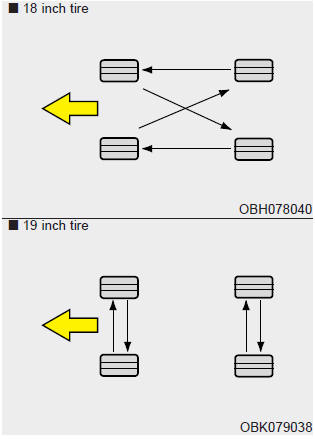 Kia K900: Tire rotation
Kia K900: Tire rotation
To equalize tread wear, it is recommended that the tires be rotated every 7,500 miles (12,000 km) or sooner if irregular wear develops. During rotation, check the tires for correct balance.
When rotating tires, check for uneven wear and damage. Abnormal wear is usually caused by incorrect tire pressure, improper wheel alignment, outof- balance wheels, severe braking or severe cornering. Look for bumps or bulges in the tread or side of tire.
Replace the tire if you find either of these conditions. Replace the tire if fabric or cord is visible. After rotation, be sure to bring the front and rear tire pressures to specification and check lug nut tightness.

Disc brake pads should be inspected for wear whenever tires are rotated.
✽ NOTICE
The front tire size is different from the rear tire size. So when you rotate tires, check the tire and wheel size.
WARNING
- Do not use the compact spare tire for tire rotation.
- Do not mix bias ply and radial ply tires under any circumstances. This may cause unusual handling characteristics that could result in death, severe injury, or property damage.
 Checking tire inflation pressure
Checking tire inflation pressure
Check your tires once a month or more.
Also, check the tire pressure of the spare tire.
How to check
Use a good quality gage to check tire pressure. You can not tell if your tires
are properly in ...
 Wheel alignment and tire balance
Wheel alignment and tire balance
The wheels on your vehicle were aligned and balanced carefully at the factory
to give you the longest tire life and best overall performance.
In most cases, you will not need to have your wheels al ...
See also:
Cruise SET Indicator Light
This indicator light illuminates:
When the cruise control speed is set. ...
Washer fluid
Checking the washer fluid level
The reservoir is translucent so that you can check the level with a quick visual
inspection.
Check the fluid level in the washer fluid reservoir and add fluid if ...
Engine compartment fuse panel (DriverŌĆÖs side)
✽ NOTICE
Not all fuse panel descriptions in this manual may be applicable to your vehicle.
It is accurate at the time of printing. When you inspect the fuse panel in your
vehicle, refer ...
